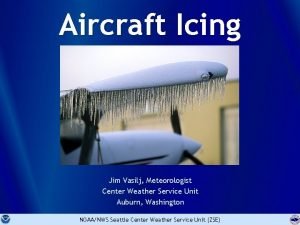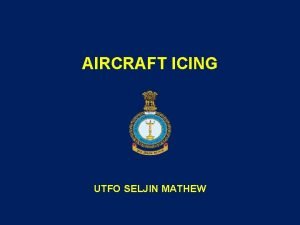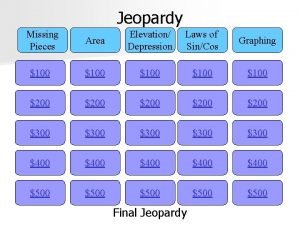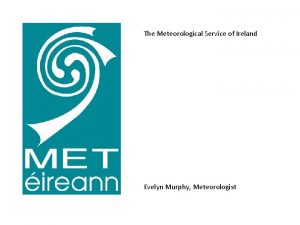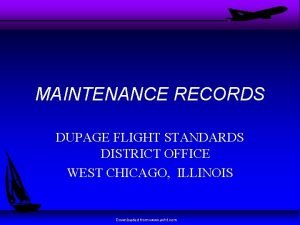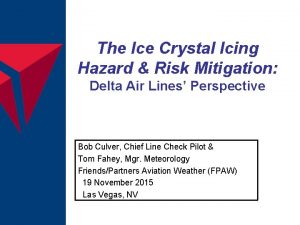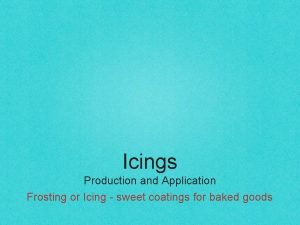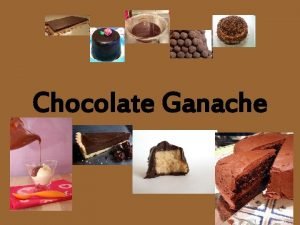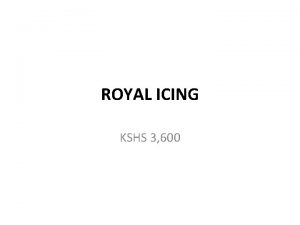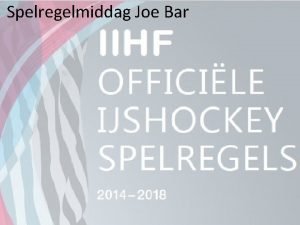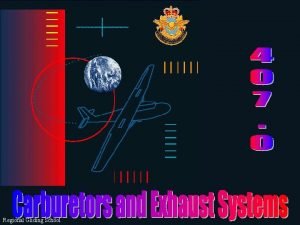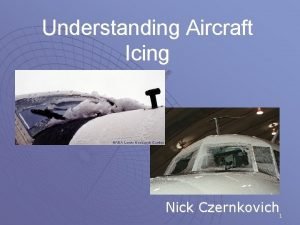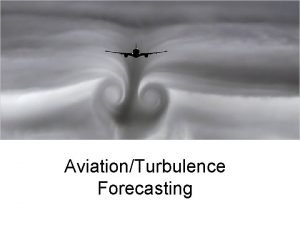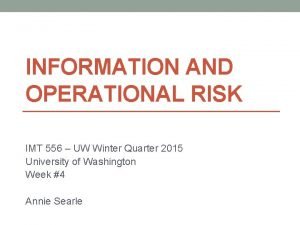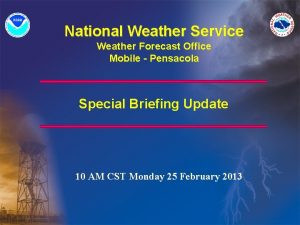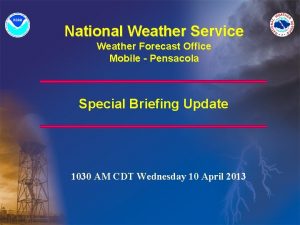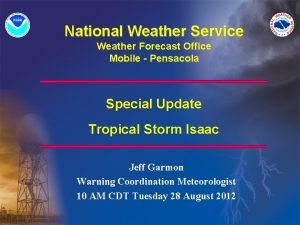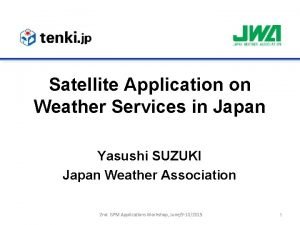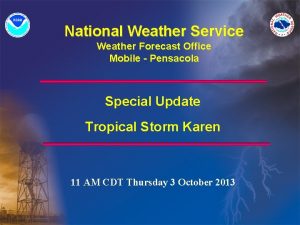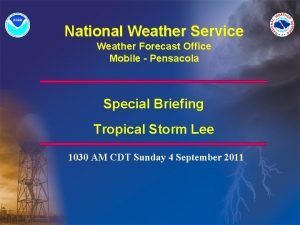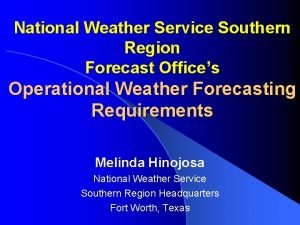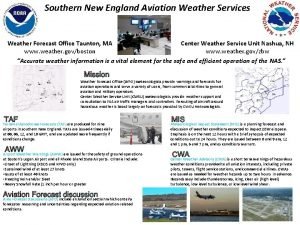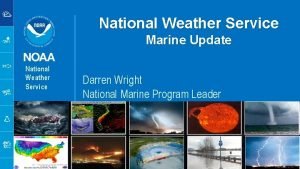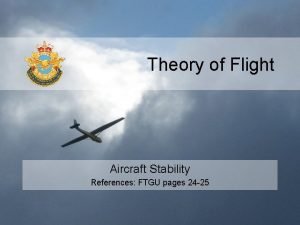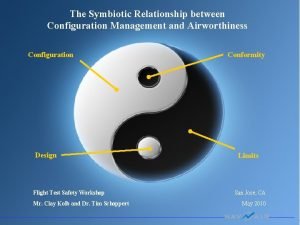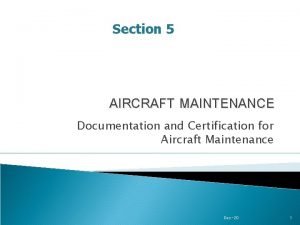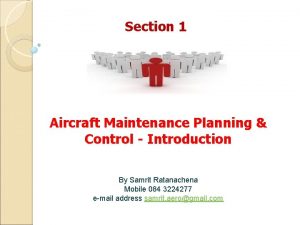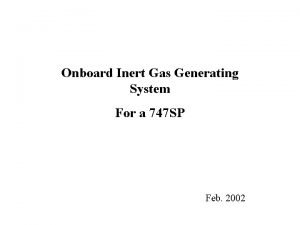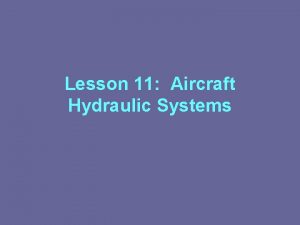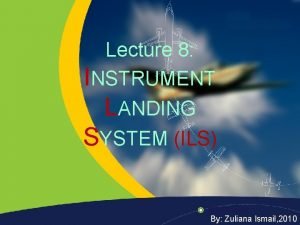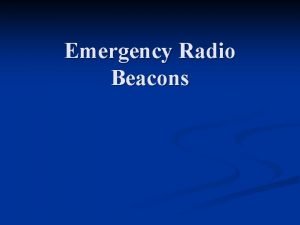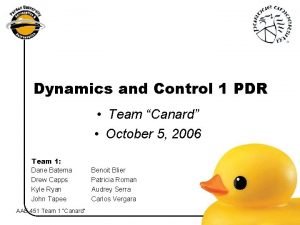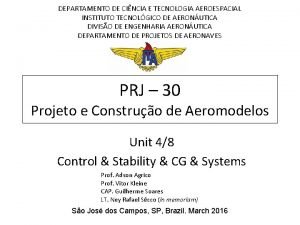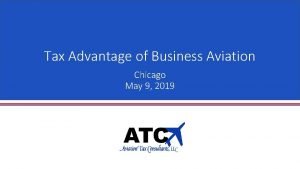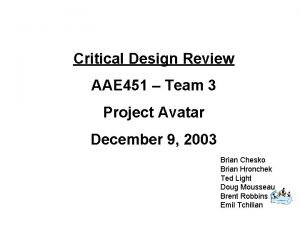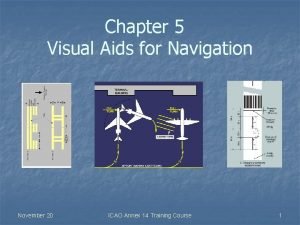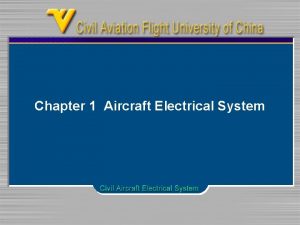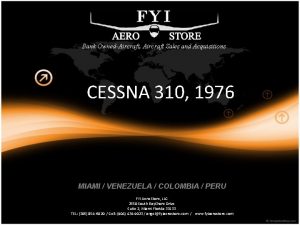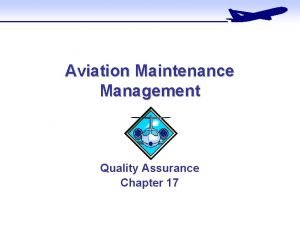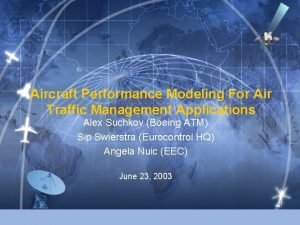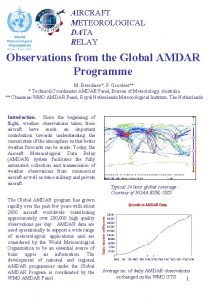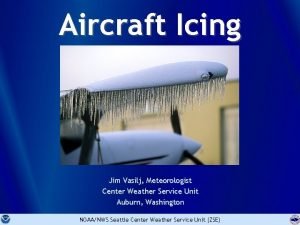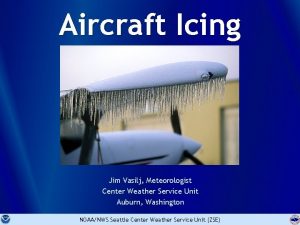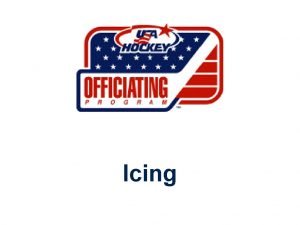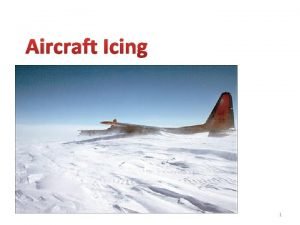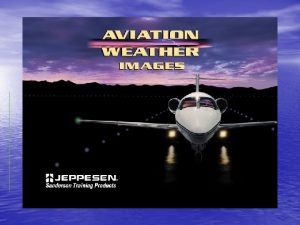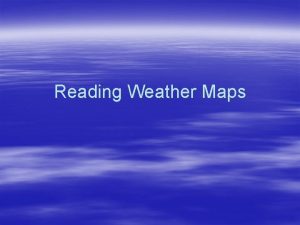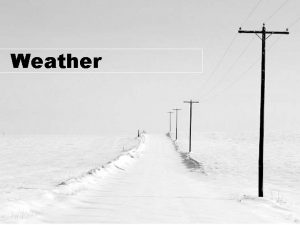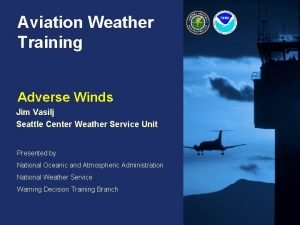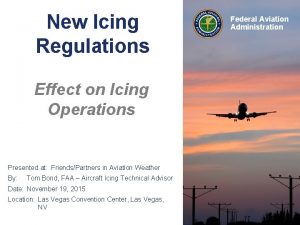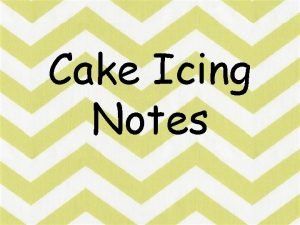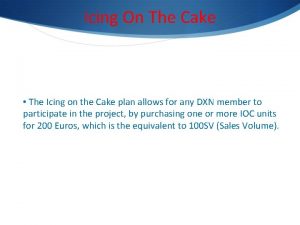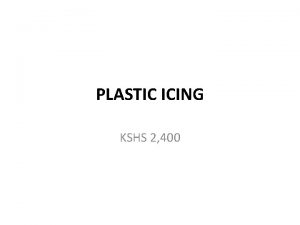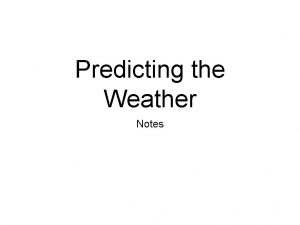Aircraft Icing Jim Vasilj Meteorologist Center Weather Service























































- Slides: 55

Aircraft Icing Jim Vasilj, Meteorologist Center Weather Service Unit Auburn, Washington NOAA/NWS Seattle Center Weather Service Unit (ZSE)

Objectives • Describe the effects of icing on aircraft performance • Explain what causes icing • Understand how ice forms and when and where it occurs • Define the 3 types of icing and their characteristics • Identify the potential type of icing based on cloud types • Explain how freezing precipitation produces aircraft icing • List strategies to maintain situational awareness for icing events 2 NOAA/NWS Seattle Center Weather Service Unit (ZSE)

Effects of Aircraft Icing Are “Cumulative” • • Decreases Lift Decreases Thrust Increases Weight Increases Drag Decreases Lift • Affects control surfaces Decreases Thrust • Affects engine performance • Increases stall speeds Increases Drag Increases Weight NOAA/NWS Seattle Center Weather Service Unit (ZSE) 3

Combined Effects Pilot Action Recommendation: Watch your outside air temperature and try to stay out of visible moisture (precipitation or clouds) anytime the temperature is below 0°C. In some instances the moisture can almost be invisible. Remember…on a standard day you lose about 2°C per thousand feet. 4 NOAA/NWS Seattle Center Weather Service Unit (ZSE)

The Cause of Icing • NOT caused by ice in clouds. • Is caused by “super-cooled” liquid water droplets in clouds… – That strike the leading edge of an airfoil and – Freeze on impact • Aircraft must be in clouds or precipitation (visible water droplets) for icing to occur 5 NOAA/NWS Seattle Center Weather Service Unit (ZSE)

Where Ice Forms • On the leading edge of the airfoil – Where the ‘Radius of Curvature’ is shortest Shortest Radius 6 NOAA/NWS Seattle Center Weather Service Unit (ZSE)

Icing Severity Factors • Liquid water content (LWC) • Temperature • Droplet size • Cloud type • Airfoil geometry • Airspeed • Duration of exposure 7 NOAA/NWS Seattle Center Weather Service Unit (ZSE)

Liquid Water Can Exist at Temperatures Below Freezing 100 C Icing can occur in this temperature range 212 F 0 C 32 F - 40 C - 40 F Icing can occur in this temperature range Called “Super-Cooled Water” 8 NOAA/NWS Seattle Center Weather Service Unit (ZSE)

“Super-Cooled” Water Formation • Begins with water in liquid form • Initial water temp can be above freezing • Water is cooled rapidly, usually by “lifting” • Water remains in liquid state at temps well below freezing 9 NOAA/NWS Seattle Center Weather Service Unit (ZSE)

“Super-Cooled” Water Formation Ice formation requires both water drops below freezing and a nucleation point. • This can be an impurity in the water (eg, dust or minerals) or ice crystals. • When the molecules align properly (this could be due to a jolt), ice will begin to Source: www. gifbay. com via giphy. com form. 10 NOAA/NWS Seattle Center Weather Service Unit (ZSE)

“Lift” Mechanisms Weather fronts Icing Cyclones Icing Orographic lift Convection 11 NOAA/NWS Seattle Center Weather Service Unit (ZSE)

Liquid Water Content (LWC) • Amount of available cloud water • Varies from cloud to cloud • Varies within same cloud…both in the horizontal and vertical 12 NOAA/NWS Seattle Center Weather Service Unit (ZSE)

Temperature • Most icing occurs between 0°C and -22°C (FL 190), however… • At -16°C (FL 160), 95% of cloud droplets have changed to ice crystals, and • At -25°C (FL 200), 99. 9% of cloud droplets have changed to ice crystals • Occurrence of icing is scarce at elevations above FL 200 or higher • Note…more than 50% of icing occurs at temps between -8°C (FL 110) and -12°C (FL 140) 13 NOAA/NWS Seattle Center Weather Service Unit (ZSE)

Temperature Most icing occurs between 0° and -20°C http: //www. casa. gov. au/fsa/2006/apr/26 -33. pdf 14 NOAA/NWS Seattle Center Weather Service Unit (ZSE)

Temperature • “Cold Soaked" aircraft can be a cause – Sustained flight in below freezing air – Descends to warm air, but… – The aircraft’s skin remains cold 15 NOAA/NWS Seattle Center Weather Service Unit (ZSE)

Water Droplet Size Icing patterns change with droplet size, but in relation to other factors…. • Droplet size not as important as… – – LWC and Temperature 16 NOAA/NWS Seattle Center Weather Service Unit (ZSE)

Cloud Type and Droplet Size • Cumulus - Large drops • Stratus - Small drops • High clouds - Ice crystals 17 NOAA/NWS Seattle Center Weather Service Unit (ZSE)

Airspeed and Duration • Aircraft type and speed affect icing occurrence Same route & altitude Wheee ! No Ice Whoaa ! Loads of ice NOAA/NWS Seattle Center Weather Service Unit (ZSE) 18

Pacific NW “Famous” for Icing • Pacific Ocean to our west for ~ Source of Abundant Moisture • North-South mountain ranges with prevailing westerly wind flow for ~ Sustained orographic, upslope flow • Sustained low level onshore flow • Low freezing levels fall, winter, and spring 19 NOAA/NWS Seattle Center Weather Service Unit (ZSE)

Icing Study by UW Axis of max LWC is also max icing potential and is often same as descent from over Cascades (Note: Height and distance not to scale. ) NOAA/NWS Seattle Center Weather Service Unit (ZSE) 20

Reportable Icing Intensities Trace Perceptible, no significant accumulation Deicing equipment may not be necessary Light Significant accumulation for a prolonged flight (over 1 hour) Occasional use of deicing equipment Moderate Significant accumulation for short periods of flight The use of deicing equipment or flight diversion is necessary Severe Rapid, dangerous accumulations Deicing equipment fails to reduce the hazard Definitions used in all FAA, DOC, and DOD handbooks, manuals and publications 21 NOAA/NWS Seattle Center Weather Service Unit (ZSE)

Types of Icing Frequency of Occurrence • Clear • Mixed • Rime Temperature Range Clear 0° to -10°C (32° to 14°F) Mixed -10° to -15°C (14° to 5°F) Rime -15° to -40°C (5° to -40°F) 22 NOAA/NWS Seattle Center Weather Service Unit (ZSE)

Clear Icing Large drops Leading edge of Wing 23 NOAA/NWS Seattle Center Weather Service Unit (ZSE)

Clear Icing • Transparent, “Glossy” • Not easily seen at first • Can spread out on airfoil beyond “reach” of de-icing equipment • Hard, heavy, and tenacious 24 NOAA/NWS Seattle Center Weather Service Unit (ZSE)

Gray is region where air is stagnant. Clear Icing • Tends to form ‘Horns’ at leading edge of airfoil. • More difficult to remove with de-icing equipment. No Icing • Disrupts and makes airflow more turbulent 25 NOAA/NWS Seattle Center Weather Service Unit (ZSE)

Icing Accretion Example Source: www. gifbay. com via giphy. com The super-cooled water is forming ice as it hits the already frozen ice cube, similar to Clear Icing. 26 NOAA/NWS Seattle Center Weather Service Unit (ZSE)

Rime Icing Trapped air Small drops Leading edge of Wing 27 NOAA/NWS Seattle Center Weather Service Unit (ZSE)

Rime Icing • • Is opaque Easily seen Lighter than clear ice However…shape and rough surface decrease aircraft aerodynamics • Easier to remove than clear ice 28 NOAA/NWS Seattle Center Weather Service Unit (ZSE)

Rime Icing • Tends to form at leading edge of airfoil • Easier for deicing equipment to remove Gray is region where air is stagnant. Rime Clear • Compare with ‘horns’ of clear icing. 29 NOAA/NWS Seattle Center Weather Service Unit (ZSE)

Mixed Icing • Mixture of Clear and Rime ice • Easily seen at first • Forms when water drops vary in size or when liquid drops are intermingled with snow and ice • Same hazards as Clear icing… – Can spread out on airfoil beyond “reach” of de-icing equipment 30 NOAA/NWS Seattle Center Weather Service Unit (ZSE)

Mixed Icing • Also tends to form ‘Horns’ at leading edge of airfoil. • More difficult to remove with de-icing equipment. 31 NOAA/NWS Seattle Center Weather Service Unit (ZSE)

Icing vs Cloud Type Stratiform Clouds • Small Cloud Droplets • Rime/Mixed most common • Usually confined to layer 3, 000 -4, 000’ thick • Max values occur in upper part of cloud • Large horizontal extent 32 NOAA/NWS Seattle Center Weather Service Unit (ZSE)

Icing versus Cloud Type Cumuliform Clouds • Large Cloud Droplets • Heavy Clear Icing found in “updraft” portion of cloud • Heavy rime most frequently in cloud tops • Clear icing most likely in building Cu • Rime often found in fully developed TS • Relatively small horizontal extent 33 NOAA/NWS Seattle Center Weather Service Unit (ZSE)

Icing versus Cloud Type • Previous statements “generally” true… • BUT research has found… – Mixed-phase clouds of all types may harbor sufficient amounts of Super-Cooled water. 34 NOAA/NWS Seattle Center Weather Service Unit (ZSE)

Typical Wintertime Rime Icing Event Eastern WA • Status fills Columbia Basin * View from satellite * • Cloud tops FL 040 – FL 050 • Cloud top temps 0° to -2°C • Light to moderate rime icing * View from ridgetop * No icing here …shallower cloud tops ~ FL 015…temps above freezing 35 NOAA/NWS Seattle Center Weather Service Unit (ZSE)

Fog at Below Freezing Temperatures Freezing Fog • Fog is made of “Super. Cooled” water droplets • When Freezing Fog comes into contact with a surface below freezing, it will turn to ice from Jackson KY NWS: http: //www. crh. noaa. gov/jkl/? n=fog_types 36 NOAA/NWS Seattle Center Weather Service Unit (ZSE)

Fog at Below Freezing Temperatures Ice Fog • Fog is made of tiny ice crystals that are suspended in the air • Only found in very cold air masses, with the temperature generally below -10°C (14°F) from Jackson KY NWS: http: //www. crh. noaa. gov/jkl/? n=fog_types 37 NOAA/NWS Seattle Center Weather Service Unit (ZSE)

Freezing Rain • Occurs when warm, moist air is forced over cold (often dry) air. • Forcing can be done by – Terrain (Mountains) – Fronts – Cold air outflow (Columbia River Gorge) 38 NOAA/NWS Seattle Center Weather Service Unit (ZSE)

Freezing Rain • Warm air/moisture overrunning cold air • Precipitation begins as rain (or melted snow) – falls through cold air – becomes “Super-Cooled Water” – freezes on impact • Quite common in the Pacific Northwest Can result in heavy icing in a short period of time 39 NOAA/NWS Seattle Center Weather Service Unit (ZSE)

Precipitation begins as rain Warm, moist air being forced aloft Cold Air Becomes freezing rain 40 NOAA/NWS Seattle Center Weather Service Unit (ZSE)

Freezing Rain • Warm, moist air over-running cold air • Precipitation begins as snow, changes to rain – – – Then falls through Cold air Becomes “Super-Cooled Water” Freezes on impact • Heavy icing in a short period of time • Best maneuver may be to gain altitude – Check with a weather briefer first! 41 NOAA/NWS Seattle Center Weather Service Unit (ZSE)

Typical Freezing Rain / Sleet Soundings 42 NOAA/NWS Seattle Center Weather Service Unit (ZSE)

Typical Freezing Rain/Sleet Soundings 43 NOAA/NWS Seattle Center Weather Service Unit (ZSE)

American Eagle #4184 • 31 October 1994 • An ATR-72 was scheduled to 4: 10 pm departure from IND to ORD • Entered holding pattern at 10, 000 ft • Flight Data Recorder recorded activation of Level III de-icing during decent to 10, 000 ft 44 NOAA/NWS Seattle Center Weather Service Unit (ZSE)

American Eagle #4184 • Ridge of ice accreted beyond the deicing boots during freezing rain/drizzle in holding pattern • The airplane went into a roll, followed by a rapid decent due to the cumulative effects of clear ice. • 68 people died near Roselawn IN. 45 NOAA/NWS Seattle Center Weather Service Unit (ZSE)

American Eagle #4184 A field near Roselawn, Ind. , was strewn with debris including a portion of the red, white and blue tail section of American Eagle Flight 4184, after it crashed on Oct. 31, 1994, killing all 68 people aboard. Wreckage of the 7 -month-old twin-engine propjet was scattered across a muddy 40 -acre soybean field in Northwest Indiana 30 miles south of Gary. (Photo: Charles Bennett / Associated Press) via Indianapolis Star Crash investigators search the site of the crash of American Eagle flight 4184 in a field near Roselawn, Ind. in the days after the Oct. 31, 1994 crash. Associated Press file via Daily Herald 46 NOAA/NWS Seattle Center Weather Service Unit (ZSE)

Situational Awareness • Keep current with the weather in your area • Know where the fronts are located • Keep current with freezing levels in your area http: //www. aviationweather. gov/gairmet 47 NOAA/NWS Seattle Center Weather Service Unit (ZSE)

Situational Awareness • Know current and forecast icing potential http: //www. aviationweather. gov/icing/fi p Current. . . FL 030 to FL 300 including SLD. (SLD…Super-cooled Large Drops) Forecast … 0 to 18 hours 010 to FL 290 Delineates general areas of icing potential 48 NOAA/NWS Seattle Center Weather Service Unit (ZSE)

Situational Awareness • Know the cloud bases • Know the cloud tops…light, non-turbo aircraft may not be able to climb above 8, 000 ft. Once on top…can they stay there? • Are clouds air mass or frontal? Frontal clouds cover larger areas…aircraft flying through frontal clouds may experience icing conditions for a longer period of time. • Are alternate routes available…around fronts or around mountains? 49 NOAA/NWS Seattle Center Weather Service Unit (ZSE)

CWSUs - Why are we here? The result of Southern Airways Flight 242 crash in New Hope, GA on April 4, 1977… 72 souls lost Total loss of thrust from both engines due to damage from ingest of water/hail while penetrating an area of severe thunderstorms Source: NTSB CWSUs established by FAA in 1978 as a result of NTSB recommendation A-77 -068 to formulate procedures for the timely dissemination of all available severe weather information by controllers “…limitations in the Federal Aviation Administration’s air traffic control system which precluded the timely dissemination of real-time hazardous weather information to the flight crew. ” – NTSB-AAR-78 -3, Jan 1978 NOAA/NWS Seattle Center Weather Service Unit (ZSE) 50

CWSU Operations • 3 Meteorologists and 1 Manager • Open 5 am – 9 pm • Provide 2 stand-up briefings perday • Answer questions from TMU, OM, FLMs, TRACONs, towers, etc • Coordinate TAFs, SIGMETs, CWAs, etc with other NWS offices • Issue CWAs, keep web page updated, participate in conference calls 51 NOAA/NWS Seattle Center Weather Service Unit (ZSE)

ZSE CWSU Web Page Headlines and Weather Story Drop-Down Menus Updated by 5: 45 am 12: 30 pm 8: 30 pm Interactive Map https: //www. weather. gov/zse 52 NOAA/NWS Seattle Center Weather Service Unit (ZSE)

Winter Forecast https: //www. cpc. ncep. noaa. gov/ Precipitation Probability (Pac. NW – Neutral) Temperature Probability (Pac. NW – Above Average) 53 NOAA/NWS Seattle Center Weather Service Unit (ZSE)

Thank you for your participation! Please come to any of us (or call x 3741) with questions you may have! 54 NOAA/NWS Seattle Center Weather Service Unit (ZSE)

55
 James vasilj
James vasilj Seljin
Seljin A meteorologist measures the angle of elevation
A meteorologist measures the angle of elevation Albert flores meteorologist
Albert flores meteorologist Meteorologist ireland
Meteorologist ireland Dupage flight center aircraft maintenance
Dupage flight center aircraft maintenance Ice crystal icing
Ice crystal icing Buttercream icings are light, smooth mixtures of
Buttercream icings are light, smooth mixtures of Ganache
Ganache Royal icing ce
Royal icing ce Icing sugar wiki
Icing sugar wiki Icing regel
Icing regel Carburetor icing
Carburetor icing Clear ice vs rime ice
Clear ice vs rime ice Station model
Station model Tongue twister summer
Tongue twister summer Short poem about seasons
Short poem about seasons It's windy weather it's stormy weather
It's windy weather it's stormy weather Whether the weather
Whether the weather Heavy weather by weather report
Heavy weather by weather report Capital weather gang weather wall
Capital weather gang weather wall Awc aviation weather
Awc aviation weather Imt 556
Imt 556 Styx river flood stage
Styx river flood stage National weather service mobile pensacola
National weather service mobile pensacola Nws mobile pensacola
Nws mobile pensacola Japan weather service
Japan weather service National weather service pensacola
National weather service pensacola National weather service pensacola
National weather service pensacola National weather service southern region
National weather service southern region Jersey aviation forecast
Jersey aviation forecast National weather service marine
National weather service marine Forward cg vs aft cg
Forward cg vs aft cg Aircraft configuration management
Aircraft configuration management Aircraft maintenance documentation
Aircraft maintenance documentation Aircraft maintenance planning and control
Aircraft maintenance planning and control Ogv aircraft engine
Ogv aircraft engine Onboard inert gas generation system
Onboard inert gas generation system Logbook entry examples
Logbook entry examples Aircraft instrument system
Aircraft instrument system Aircraft hydraulic system
Aircraft hydraulic system Marker ils
Marker ils Aircraft financing structures
Aircraft financing structures Grumman aircraft engineering corporation
Grumman aircraft engineering corporation Beacon
Beacon Pdr team
Pdr team Aircraft static margin
Aircraft static margin Daniel cheung aviation tax
Daniel cheung aviation tax Aircraft static margin
Aircraft static margin Aircraft stand markings
Aircraft stand markings Aircraft electrical system components
Aircraft electrical system components Bank owned aircraft for sale
Bank owned aircraft for sale Aviation maintenance quality management
Aviation maintenance quality management Aircraft builders council
Aircraft builders council Vertical game
Vertical game Aircraft meteorological data relay
Aircraft meteorological data relay
